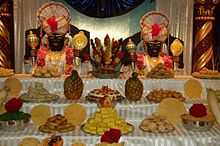Govardhan Puja

Govardhan Puja, also called Annakut (meaning a heap of grain) , is celebrated as the day Krishna defeated Indra by lifting the Govardhan hill.[1][2][3] It is the fourth day of Deepawali (Diwali), the Hindu festival of lights.
The day is celebrated on the first lunar day of Shukla Paksha (bright fortnight) in the Hindu calendar month of Kartik.
Legends

According to legends, Lord Krishna taught people to worship the Supreme Controller of nature, God, specifically Govardhan, as Govardhan is a manifestation of Krishna, and to stop worshiping the God of Rains, Lord Indra. For Annakut a mountain of food is decorated symbolizing Govardhan mountain said to be lifted by Lord Krishna to save the people from the wrath of Lord Indra, the demigod in charge of rain. This pooja is performed with great zeal and enthusiasm and in the states of Punjab, Haryana, Uttar Pradesh and Bihar. In Haryana, there is a tradition of building cow dung hillocks, which symbolize the Mount Govardhan, the mountain which was once lifted by Lord Krishna. After making such hillocks people decorate them with flowers and then worship them. They move in a circle all round the cow dung hillocks and offer prayers to Lord Govardhan.
Celebrations
Govardhan Puja forms an important part of the celebrations of Diwali.
In Maharashtra it is celebrated as Padva or BaliPratipada. The day commemorates King Bali. Men present gifts to their wives on this day.
In Haryana, Gujarat, it is celebrated as New Year, as Vikram Samvat starts on this day.
In many parts of India, Vishwakarma Puja is also celebrated on the day following Diwali, first Lunar Night of the Shukla paksha of the Hindu month of Kartik. The day, called Vishwakarma Day is marked as an official holiday for most manufacturing and primary sector units, with people taking leave from factories, schools, farms and other places of work. This day is celebrated by worshipping the tools one uses in daily life; for example, hammer, sickle, tractors etc. and has no religious boundaries.[4]
Vishwakarma, as legend has it was a mythical architect to the Gods, and was the chief engineer of kingdoms like Dwarka of Krishna, Lanka of Kubera, and the Swarg, or Heaven of Indra. He is the patron God of architects and engineers.
References
- ↑ J. Gordon Melton (2011). Religious Celebrations: An Encyclopedia of Holidays, Festivals, Solemn Observances, and Spiritual Commemorations. ABC-CLIO. pp. 341–342. ISBN 978-1-59884-205-0.
- ↑ "‘Govardan puja’ performed". The Hindu. October 25, 2014. Retrieved 2014-10-26.
- ↑ Michael Charles Baltutis (2008). The Festival of Indra: The Construction of a South Asian Urban Celebration. ProQuest. pp. 86–. ISBN 978-0-549-75127-4.
- ↑ Shobna Gupta (2010). Festivals Of India. Har-Anand Publications. pp. 84–. ISBN 978-81-241-1277-9.
| |||||||||||||||||||||||||
